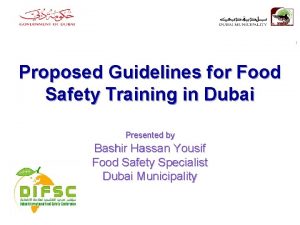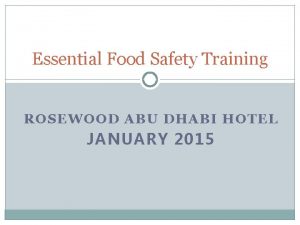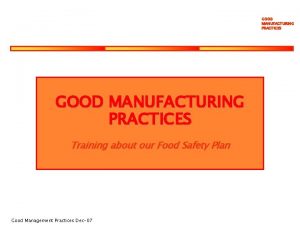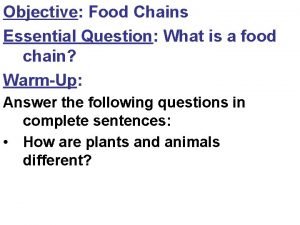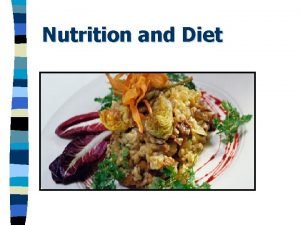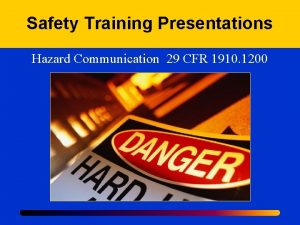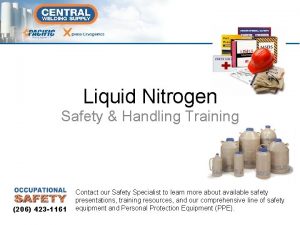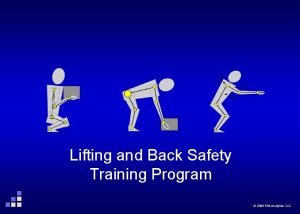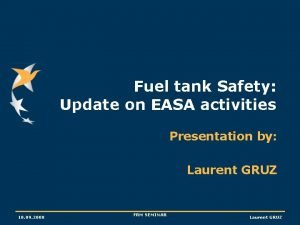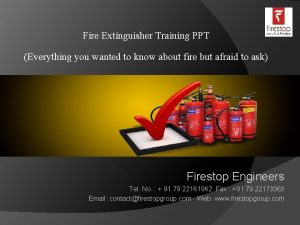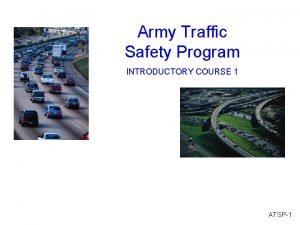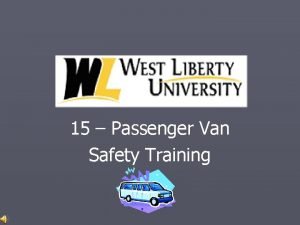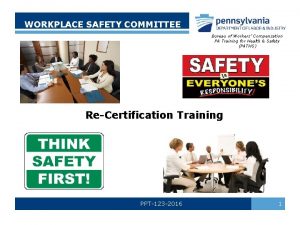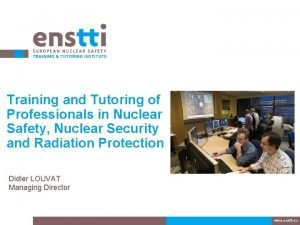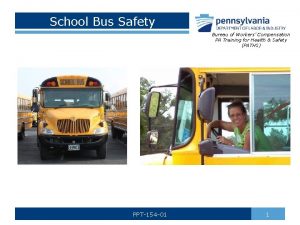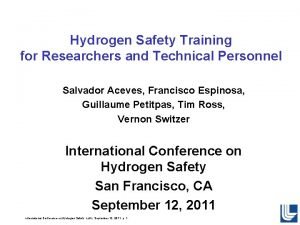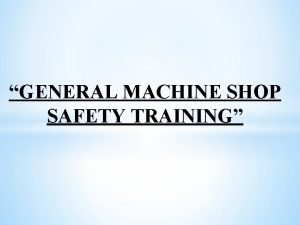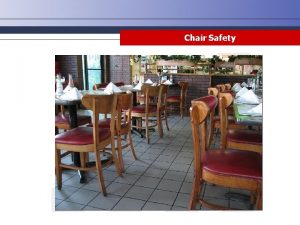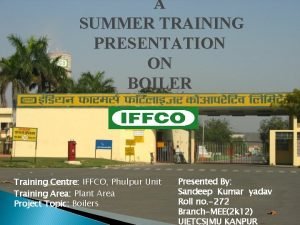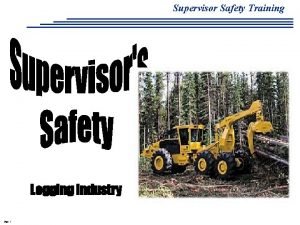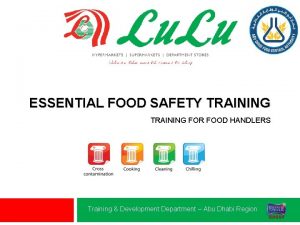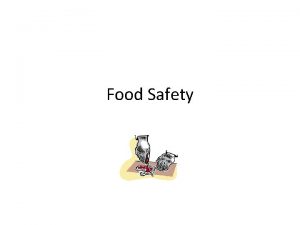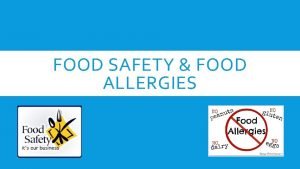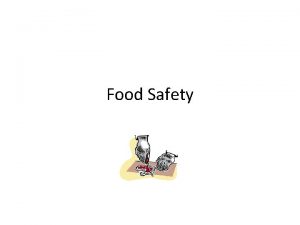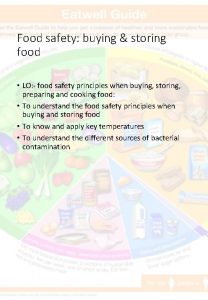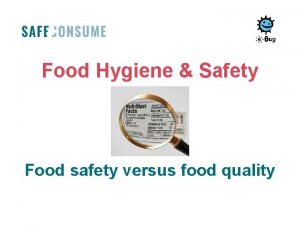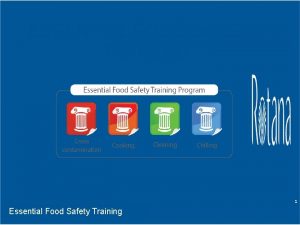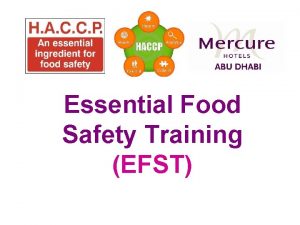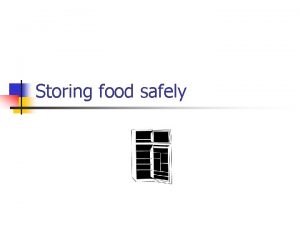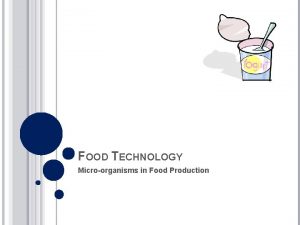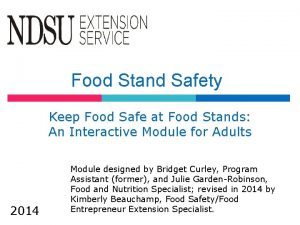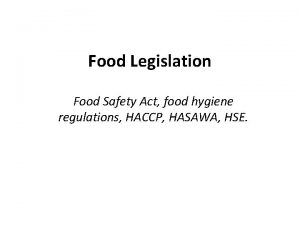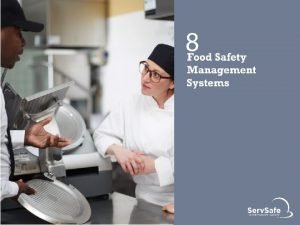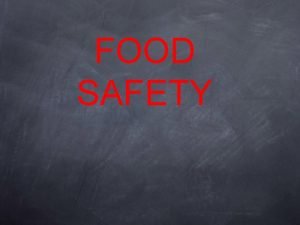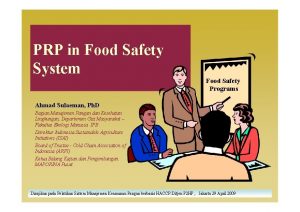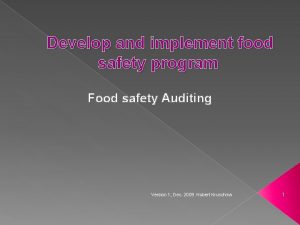ESSENTIAL FOOD SAFETY TRAINING Essential food safety Training
































- Slides: 32

ESSENTIAL FOOD SAFETY TRAINING Essential food safety Training Americana Company 1

1 INTRODUCTION TO FOOD SAFETY Essential food safety Training Americana Company 2

IMPORTANCE OF FOOD SAFETY § Food borne disease is a serious problem that affects every country in the world. § It can cause vomiting, diarrhea and fever, and in some cases it can be deadly. § Food borne disease can affect anyone, but some people are more at risk. For § example, young children, the elderly, pregnant women and people who are unwell Essential food safety Training Americana Company 3

FOOD SAFETY HAZARDS § There are three main types of food safety hazards: § 1. Microbiological (e. g. Bacteria) § 2. Chemical (e. g. cleaning chemicals, pesticides, etc. ) § 3. Physical (e. g. broken glass, hair, etc. ) Essential food safety Training Americana Company 4

The Nature Of Bacteria are very small organisms that cannot be seen without a microscope Types of Bacteria § Harmful bacteria causing the disease. § Food Spoilage bacteria (grow on food). § Useful (used in the yogurt). Essential food safety Training Americana Company 5

WHAT ARE THE SOURCES OF BACTERIA? Waste Dirt Water Food Pests People Essential food safety Training Americana Company 6

2 CROSS CONTAMINATION Essential food safety Training Americana Company 7

CROSS CONTAMINATION Spreading contamination from one food to another food Direct Contamination Indirect Contamination Raw d e Cock Raw e c a f r Su ed k c o C 8 Essential food safety Training Americana Company

PREVENTING CROSS CONTAMINATION When preparing food… Never allow one food to come into contact with another food Here are some ways that you can prevent Cross Contamination Liquid Soap Wash hands before & after handling each food item Wash, rinse & sanitize every item/surface before & after it comes into contact with food Essential food safety Training Replace gloves after handling different food items Wash fresh produce before preparing Prepare only one item at a time Keep raw foods away from all other foods, raw, ready-to-eat or cooked Use separate equip & utensils for each type of food being prepared Americana Company 9

HAND WASHING Wash in warm water. Rub with soap for 20 seconds. Rinse thoroughly. Dry with a clean Disposable towel. Essential food safety Training Americana Company 10

WHEN TO WASH HANDS § § § § Before you start your shift Before touching any food After using the toilet facilities After coughing or sneezing After touching your hair, face, or body parts After handling rubbish or cleaning After smoking and breaks Every maximum ½ an hour Hands can easily spread bacteria. They must be thoroughly washed and dried in-between tasks, especially before touching ready-to-eat food and after touching raw food. Essential food safety Training Americana Company

PROTECTIVE CLOTH Hat (or hairnet) Long sleeved jacket, light color and Washable Clean apron Clean shoes The clothes are vital means for cross contamination Essential food safety Training Americana Company 12

USING CLOTHS Single-use cloths (e. g. disposable paper towels) are safest for wiping Surfaces and utensils. § They must be thrown away after each task Re-usable cloths (e. g. dish towels) can easily pick up bacteria and spread them. Single-use cloths (e. g. paper towels) are safer as they are thrown away after each task. Essential food safety Training Americana Company 13

WOUNDS & JEWELRY Essential food safety Training Americana Company 14

FITNESS FOR WORK Essential food safety Training Americana Company 15

PEST CONTROL Signs of pests: Droppings, holes in walls, gnaw marks. Essential food safety Training Signs of pests: insect egg cases, insect skins, webs. Americana Company 16

PRINCIPLES OF PEST CONTROL § Cleanliness is first step § Use non-chemical methods first: Electric Fly Killer (EFK), Traps and Glue boards § Check all parts of premises for signs of pests. § Check deliveries for signs of pests. § Dispose of waste frequently & maintain the waste storage areas clean. § Report signs of pests to the manager. Essential food safety Training Americana Company 17

3 CLEANING & DISINFECTION Essential food safety Training Americana Company 18

CLEAN VS. DISINFECTION Clean: Is to free the surface from any visible dirt/soils. Disinfection : Is to free/minimize the surface from bacteria or micro -organism or to reduce it to a safe level. Essential food safety Training Americana Company 19

DETERGENTS AND DISINFECTANTS § Detergents: Used to remove any visible dirt/soils: such as (KAY detergent) § Disinfectants : Used to kill the bacteria or minimize to acceptable levels such as (KAY Sanitizer). Remember: the high-risk areas need detergent and sanitizer together to clean. Essential food safety Training Americana Company 20

CLEANING AND DISINFECTION Essential food safety Training Americana Company 21

OTHER DISINFECTION METHODS Heat kills bacteria, so if a cleaning method uses very hot water (e. g. a dishwashing machine) the bacteria will all be killed. This is another method of 'disinfection'. Essential food safety Training Americana Company 22

HIGH-RISK & LOW-RISK AREAS Some items and areas are 'high risk' because they come into direct contact with food or hands. They need to be disinfected to kill bacteria, whereas ‘low risk' items and areas do not. Essential food safety Training Americana Company

4 COOKING Essential food safety Training Americana Company 24

DANGER ZONE Bacteria grow quickly in warm temperatures. When they get very cold they stop growing, and when they get very hot they are killed, so keep food either hot or cold. Essential food safety Training Americana Company

COOKING Essential food safety Training Americana Company 26

HOT HOLDING AND RE-HEATING Hot-holding § When hot-holding, food must be kept hot to stop bacteria from growing Food that is stored or displayed hot must be kept at 63°( or above for a maximum of 2 hours. § If there is no temperature measurement, the food must be visually hot (e. g. steaming) to show that it is still safe. Re-heating § When re-heating, food must get hot enough to kill bacteria. § It must be bubbling / steaming throughout to show that a safe temperature has been reached. When hot-holding, food must be kept hot to stop bacteria from growing. When re-heating, food must get hot enough to kill bacteria. Essential food safety Training Americana Company 27

5 CHILLING Essential food safety Training Americana Company 28

COOLING PROCEDURE § The best method of chilling hot food is with specialist chilling equipment (e. g. a blast chiller) (cool the food within 90 Minutes) § Reduce the size of the item you are trying to cool, smaller items will cool faster. § Use shallow containers and reduce thickness in the container. § Use an ice bath to quickly reduce food temperatures. § Stir the item as they cool. Essential food safety Training Americana Company 29

COLD AND FROZEN STORAGE Many types of food need to be kept at cold temperatures to reduce the growth of bacteria. Storage and display equipment should keep food below 5°C Food also needs to be labeled and used within its shelf life Food can be kept for longer periods of time if it is frozen. Freezing temperatures (i. e. -18°C) stop all bacteria growing. Food should be kept in air-tight packaging and labeled with the date of freezing Essential food safety Training Americana Company 30

SAFE THAWING METHODS § Thawing is commonly the first stage of processing for several of our products in the restaurant. This must be done properly to avoid cross contamination. § There are two effective types of thawing that we use in our restaurants: 1. Refrigerated thawing 2. Running water thawing Essential food safety Training Americana Company 31

Food Safety is Everyone’s Responsibility Essential food safety Training Americana Company 32
 Safety care certification
Safety care certification Plamatic acid
Plamatic acid Food hygiene training in dubai
Food hygiene training in dubai Food safety training abu dhabi
Food safety training abu dhabi Gmp food safety training
Gmp food safety training Food safety food security
Food safety food security Unit 2 food food food
Unit 2 food food food Grazing food chain diagram
Grazing food chain diagram Lab safety essential questions
Lab safety essential questions Food chain zebra
Food chain zebra N
N Safety depth formula in ecdis
Safety depth formula in ecdis Process safety vs personal safety
Process safety vs personal safety Safety assessment for ind safety reporting
Safety assessment for ind safety reporting Basic safety (construction site safety orientation)
Basic safety (construction site safety orientation) Basic safety orientation
Basic safety orientation 29 cfr 1910 osha 178
29 cfr 1910 osha 178 Liquid nitrogen training
Liquid nitrogen training Safety awareness topics
Safety awareness topics Fuel tank safety training
Fuel tank safety training Basic fire fighting training ppt
Basic fire fighting training ppt Army traffic safety course
Army traffic safety course 15 passenger van safety training
15 passenger van safety training Pa safety committee
Pa safety committee Nuclear safety training
Nuclear safety training Stairways and ladders osha
Stairways and ladders osha Flagman safety training ppt
Flagman safety training ppt Hydrogen safety training
Hydrogen safety training Pinch point safety definition
Pinch point safety definition Chair inspection checklist
Chair inspection checklist Boiler safety ppt
Boiler safety ppt Power tools ppt
Power tools ppt Supervisor safety training topics
Supervisor safety training topics


